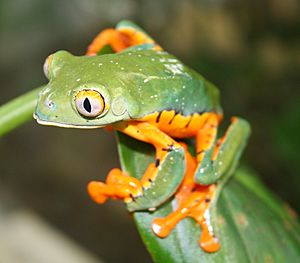Splendid leaf frog facts for kids
Quick facts for kids Splendid leaf frog |
|
|---|---|
 |
|
| Conservation status | |
| Scientific classification | |
| Synonyms | |
|
The splendid leaf frog (also known as the splendid treefrog) is a beautiful frog. Its scientific name is Cruziohyla calcarifer. A scientist named George Albert Boulenger first described it in 1902. This frog is part of the tree frog family.
You can find this frog in several countries. It lives in northwestern Ecuador, western Colombia, and Panama. Its home also extends to the very southern part of Costa Rica. This frog prefers warm, wet lowland forests. It is a nocturnal animal, meaning it is active at night. It is also arboreal, which means it lives mostly in trees.
Contents
About the Splendid Leaf Frog
The splendid leaf frog is known for its amazing looks. It has bright colors and unique patterns. These colors help it blend in with its forest home. It spends most of its life high up in the trees. This helps it find food and stay safe from predators.
Where it Lives
This frog lives in humid lowland forests. These forests are usually very wet and warm. They provide the perfect home for the splendid leaf frog. It needs these specific conditions to survive. The frog's range covers parts of Central and South America.
Night Life of the Frog
Since it is nocturnal, the splendid leaf frog hunts at night. It uses its excellent eyesight to find insects. During the day, it rests hidden among the leaves. This keeps it safe from animals that hunt during daylight hours.
Frog Family Tree
Scientists study the DNA of animals. This helps them understand how different species are related. They found that the splendid leaf frog is quite unique. It is the most different species in its group, called Cruziohyla.
DNA tests show that Cruziohyla sylviae is closely related to Cruziohyla craspedopus. These two are like "sister species." However, the splendid leaf frog (Cruziohyla calcarifer) is a bit more distant. It has its own special place in the frog family tree. This means it branched off earlier in evolution.
See also

- In Spanish: Rana espléndida para niños


